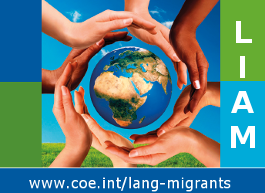Language policies for adult migrants
The language policies which member states put in place for adult migrants must first of all fit in with the aims of the reception arrangements they are subject to. These principles can only be interpreted here as the general principles of the Council of Europe: promotion of human rights, democratic pluralism, the rule of law and measures to support social cohesion measures.
Aims of training for adult migrants
These guiding principles need to be viewed in relation to the specific context of language training for adult migrants. However, first member states need to recognise their specific responsibilities in relation to the provision of language training for these individuals, bearing in mind that for a long time s migrants themselves were seen as solely responsible for learning the language of the host society. This language support must have objectives such as ensuring a level of competence in oral communication, a crucial element of social life, in particular in the workplace. However, it should also seek to generate a sense of belonging to the migrants’ new social environment, in addition to their existing loyalties, while bearing in mind that this sense of belonging depends on the migrants’own plans (for instance, permanent or temporary settlement). Lastly, a successful integration policy also involves states equipping themselves properly to contain the fears and remove the ambiguities which the visible presence of newcomers can trigger in the host societies. Intercultural education initiatives for all (for instance, as part of compulsory education) to raise awareness about these issues. In this sense integration is clearly a two-way process.
Design of language training for adult migrants
The practical implementation of these principles depends on the design of language training, ie the general approach to developing language courses for migrants. It involves:
- profiling the learner groups concerned; for instance, “training course for migrants” does not suffice as a classification, as migrants’ language repertoires and knowledge of the host society can vary considerably;
- defining the language needs, ie the spoken and written communication situations which the migrants wish to be able to cope with, particularly in the language of the host society, but also using all the other language resources at their disposal;
- on the basis of the target situations identified, specifying learning objectives in terms of activities and descriptors of activities based on the Common European Framework of Reference for Languages (CEFR), by types of discourse (work conversation, discussion of current events, presentations, etc) and by domain such as family life, work, social life, etc;( for instance, being able to read listings of TV programmes);
- deciding on relevant objectives in terms of the structure of spoken and written texts vocabulary, morphology and syntax, etc, drawing on the reference level descriptions of the CEFR (when available) and adapting these, especially in terms of vocabulary, to the needs and expectations of migrants;
- dividing these objectivesinto sequences of activities , taking particular account of the teaching time available;
- defining the organisation of these sequences of activities;
- giving pride of place to active and self-directed teaching/learning, while taking very careful account of the learners’ educational culture, in other words, their learning habits and their expectations regarding the teaching;
- organising these sequences of activities within the available teaching time, bearing in mind the pace of learning;
- testing and having learners self-assess what has been learnt.
Quality of language training for adult migrants
Apart from the technical characteristics designed to ensure that the training on offer meets the adult migrants’ training needs, it is essential regularly to assess the overall quality of the training in terms, for instance, of the qualifications required of trainers or the relevance of training resources, external auditing of the training programmes, seeking the opinions of students and other stakeholders (employers, for instance) and overall assessment of the outcomes of training. These monitoring and quality assurance mechanisms are an essential part of managing training of this kind and assessing its impact.
The training provision should also include, as vital, cross-cutting elements:
- highlighting the value of migrants’ languages of origin in group activities in order, inter alia, to encourage their maintenance and transmission from generation to generation;
- raising awareness about how the host society works in terms of its structures and cultural and social diversity, with a view to stimulating learners to react to these and to examine these features in greater depth.
In this sense language policies for integration can be a worthwhile collective “investment”, as they contribute to social cohesion. However,explicit principles like those mentioned above may be undermined either because of technical shortcomings (which the resources on this website seek to remedy) or because they mask a policy of exclusuon in which knowledge of the language(s) of the host society is used to restrict access to it. In cases,where the design of language training is applied without social principles,it is insufficient to stem the long term.adverse effects.
JCB
Related resources
Concept Paper: The role of languages in policies for the integration of adult migrants, 2008, Jean-Claude Beacco
Adult migrant integration policies: Principles and implementation, 2010, Jean-Claude Beacco
The ‘Common European Framework of Reference for Languages’ and the development of policies for the integration of adult migrants, 2008, David Little
The linguistic integration of adult migrants and the CEFR, David Little, 2012.
Quality assurance in the provision of language education and training for adult migrants – Guidelines and options, 2008 - Richard Rossner
Learning the language of the host country for professional purposes, 2012, Claire Extramiana
Providers of courses for adult migrants- Self-assessment Handbook, 2012, Richard Rossner
Integration of Adult Migrants and Education : Extracts from Council of Europe Conventions, Recommendations and Resolutions (1968-2015)




